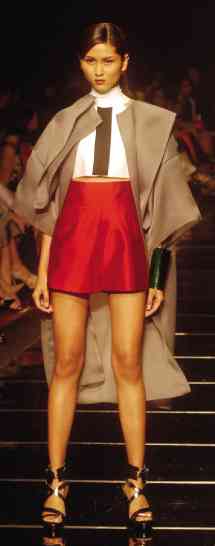
Four of the country’s leading designers stayed true to their roots while venturing beyond their comfort zones to produce fashion-forward pieces that were wearable and practical, but far from ordinary and predictable.
Seven months after they debuted in a group show dubbed “Salon,” Cesar Gaupo, Lulu Tan-Gan and Dennis Lustico again shared the ramp recently in a Spring-Summer show.
“Salon” was held at the Fairmont Hotel’s grand ballroom.
This time, Joey Samson took the place of Joji Lloren, who didn’t join to focus on his gala collection later this year.
Trademark style
Gaupo didn’t veer far from his trademark feminine, classic yet sophisticated ensembles—dresses, skirts, jumpsuits, jackets and tops in chiffon, tulle, crepe, gazar and organza.
The real challenge was to make them look current and chic, and again Gaupo proved up to the task.
Although some clothes were cinched at the waist, for instance, he produced figure-friendly pieces, using adept layering, judicious accessorizing
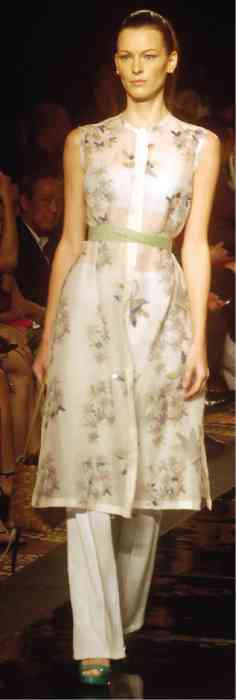
and smart proportions.
Apart from producing a visual feast through such details as peplums, extended shoulders, dolman sleeves, diaphanous jackets, overlays and hoodies, Gaupo came up with a collection that was playful and colorful enough to appeal to young women without alienating his core market of sophisticated and more mature fashionistas.
Gaupo reaffirmed his mastery of color, producing pieces in eye-catching violet and yellow, turquoise and yellow, fuchsia and orange.
He tempered the strong colors by combining them with either neutrals or all-black ensembles.
Drawing inspiration from Danish illustrator Kay Nielsen, Gaupo did electric pleating, layering and asymmetric hemlines.
Like previous works, the collection teemed with Oriental references—from the cuts and necklines to choice of colors and materials.
He let the clothes speak for themselves by limiting accessories to a few statement pieces such as belts, necklaces and sewn-in tassels, feathers and fringes.
“Every collection poses a set of challenges,” said Gaupo, still the country’s acknowledged “RTW King.” “What would your message be? You have a story to tell, and every part of that story is difficult to produce.”
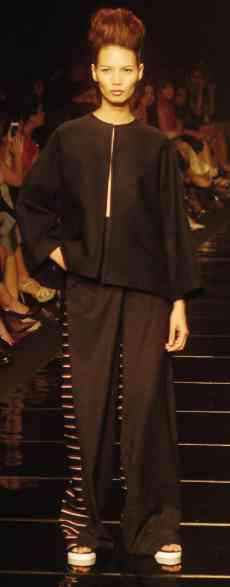
In his latest collection, Gaupo was more than just motivated. He was inspired.
Weather-friendly
Tan-Gan continued her experiments with piña without abandoning the lightweight and warm weather-friendly knits she became known for.
She also reaffirmed her undying love affair with resort fashion that’s chic enough to wear to city functions.
She paid homage to her roots by initially showing knitted dresses and separates. Tan-Gan started producing and designing knits more than 30 years ago.
The collection progressed to loose and printed piña separates serving as overlays to Tan-Gan’s trademark knitted pieces. Instead of clashing, the contrast between light and heavy materials worked.
Following the resort theme, Tan-Gan’s dominant colors were ecrus and pastels. White also prevailed.
While Tan-Gan’s earlier attempts to combine piña with knits, which began in 2005, had an ad hoc and bohemian vibe to them, this time, her
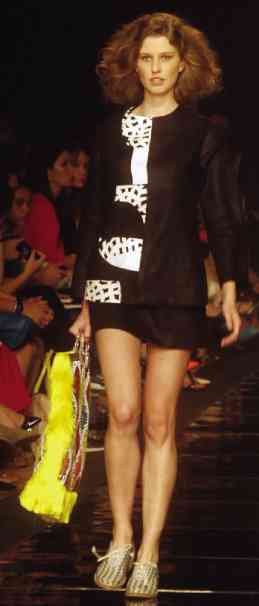
dresses and separates, including numbers noteworthy for their see-through and frayed details.
collection was more subdued, seamless and polished.
The collection, Tan-Gan said, is a “marriage of tradition and technology.” She and her collaborators not only wove and knitted the materials, in the case of piña, they also embellished them with prints.
“Unlike before, the prints that came out worked because printing didn’t tamper with piña’s ethereal qualities,” she said. “In fact, piña was smoothened after the printing process. It really takes new technology to bring the fabric forward.”
Cutting piña was one of the most tedious aspects of the collection. Since she hasn’t found a cutter meticulous and experienced enough to do the job, Tan-Gan cut every piece herself.
“I enjoy the crisp sound while cutting the piña,” she said. “I also love its featherweight character.”
Like Gaupo’s pieces, Tan-Gan’s collection was redolent with Oriental influences, from the Philippine kimona to the Vietnamese ao dai.
Homage
Like his more senior colleagues, Lustico is not afraid of colors nor of quirky juxtapositions of materials. This was evident in his collection, “Messing Up with Georgia.”
His homage to American artist Georgia O’Keeffe took the form of dresses and separates, including hot pants, noteworthy for see-through and frayed details on skirts, sleeves, bodices, hemlines and necklines.
Instead of harping on O’Keeffe’s paintings of bright, humongous flowers, Lustico opted to focus on the Wisconsin-born artist’s interpretations of landscapes from her adopted southwestern American home.
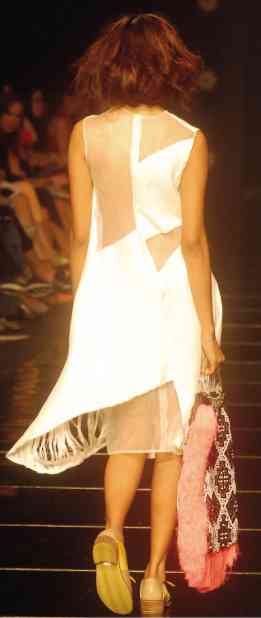 He used such colors as acid yellow, hints of nude and pink, black and white, and the quintessentially southwestern American turquoise.
He used such colors as acid yellow, hints of nude and pink, black and white, and the quintessentially southwestern American turquoise.
He also channeled the artist’s preference for dressing in loose pieces, in draped dresses with strategic cutouts, including a ladderlike detail on the neckline.
Lustico also resorted to beading, raw edges and color blocking to add texture and visual nuances to his neutral canvas. In lieu of geometric blocks of color, the designer used irregular patches of colored fabric, which he combined with see-through material either in black or white.
“If I were true to Ms O’Keeffe’s aesthetics, the collection would have come out layered and minimal,” he said. “That’s why I call it ‘messing up’ because I applied my aesthetics, which is a little more color-oriented.”
He matched clothes with beaded silk totes and clutches from his recent accessories collection for Manila FAME.
Unlikely inspirations
Samson drew unlikely inspirations from sportswear and loungewear, and combined them to produce a collection dubbed “Let’s Play Ball.”
The designer fused neutral-colored fabrics such as cotton, sports jersey, knits, corduroy and viscose twill that offered contrasting textures, prints and weights, to produce suits, jackets, shirtdresses and a billowing coat. Color was confined to few accent pieces such as vintage silk scarves in navy blue and red prints.
He also had fitted tailored pieces and a few oversized and drapey tops. Contrasting white piping and cotton trims underscored the collection’s sportswear-slash-pajama flavor, which was evident throughout the segment.
Surprise elements
Samson’s pieces also swung from serious to playful—a seemingly conventional jacket, for instance, revealed an obvious protrusion once the model turned his back.
“Those surprise elements came in the shape of a rugby ball,” said Samson, one of the industry’s most consummate tailors. “And they could be seen on the back of a jacket and the asymmetrical seams of certain tops, skirts and overskirts.”
He also played with classic prints like stripes and polka dots, which he reinvented by using exaggerated proportions and unexpected juxtapositions.
In keeping with the collection’s varsity look, certain pieces had a sporty, Ivy League feel to them, thanks to such embellishments as sewn-in patches and contrasting buttons.
Surprises extended to a number of accessories like a clutch and shoulder bag, which Samson fashioned from actual rugby and soccer balls.
“For me, the hardest but most fulfilling part is product development and exploration,” he said. “It was a challenge for me to be able to gather all the fabrics, materials, prints and textures together, and make them all work.”
PHOTOS BY ARNOLD ALMACEN








































